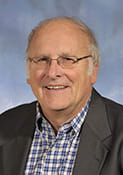 William Seaver originally came to the Haslam College of Business in 1988 as a visiting professor from Virginia Tech. Later, he left academia to spend several years working in industry before returning to the University of Tennessee in 1993.
William Seaver originally came to the Haslam College of Business in 1988 as a visiting professor from Virginia Tech. Later, he left academia to spend several years working in industry before returning to the University of Tennessee in 1993.
Seaver earned his bachelor’s and master’s of business administration degrees at the University of Texas, Austin, focusing on statistics and quantitative methods, and his PhD in statistics from Texas A&M. “I’ve been in and out of industry throughout my career, which brings a unique reality to my classes,” Seaver says. “I love to teach, and I also teach inside industry as a consultant.”
Currently, Seaver teaches only senior and graduate level courses at Haslam, including a class on time series analysis and a capstone course for undergraduates in business analytics and statistics. Seaver enjoys relaying current issues and real-life problems from industry to students. “Students in my classes get some good creative problems from an industry perspective,” he says. “I look for those types of ideas, because they help students succeed.”
When it comes to research, Seaver specializes in finding patterns in data. “I do that over time and in static databases,” he says. “We call it data mining now, but I’ve been doing that same thing for forty years.” Seaver recently co-authored a paper on bank branch operational performance for Expert Systems with Applications and published an article in the Journal of Applied Statistics on time series analysis applied to employee turnover forecasting. “One of my specialties in patterns is fuzzy analysis, which captures the vagueness of patterns in current data, and a lot of our business analytics do not currently incorporate those kinds of technologies to find those patterns,” he says. “The banking paper we just finished uses that methodology to understand profiles of banks that are not mutually exclusive.”
Seaver enjoys his work too much to retire, at least for now. “I still enjoy teaching and seeing students catch a glimpse of how neat this stuff can be,” he says. “I often get appreciative letters from students, and that makes my day.”

